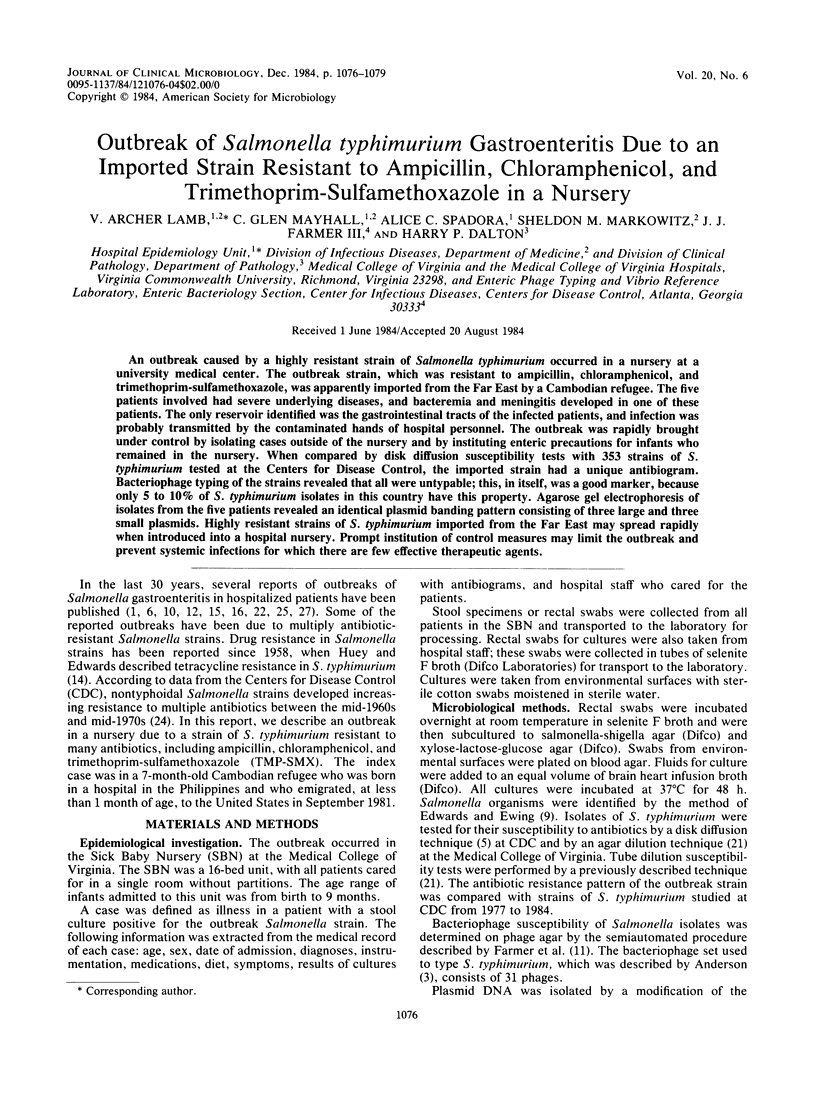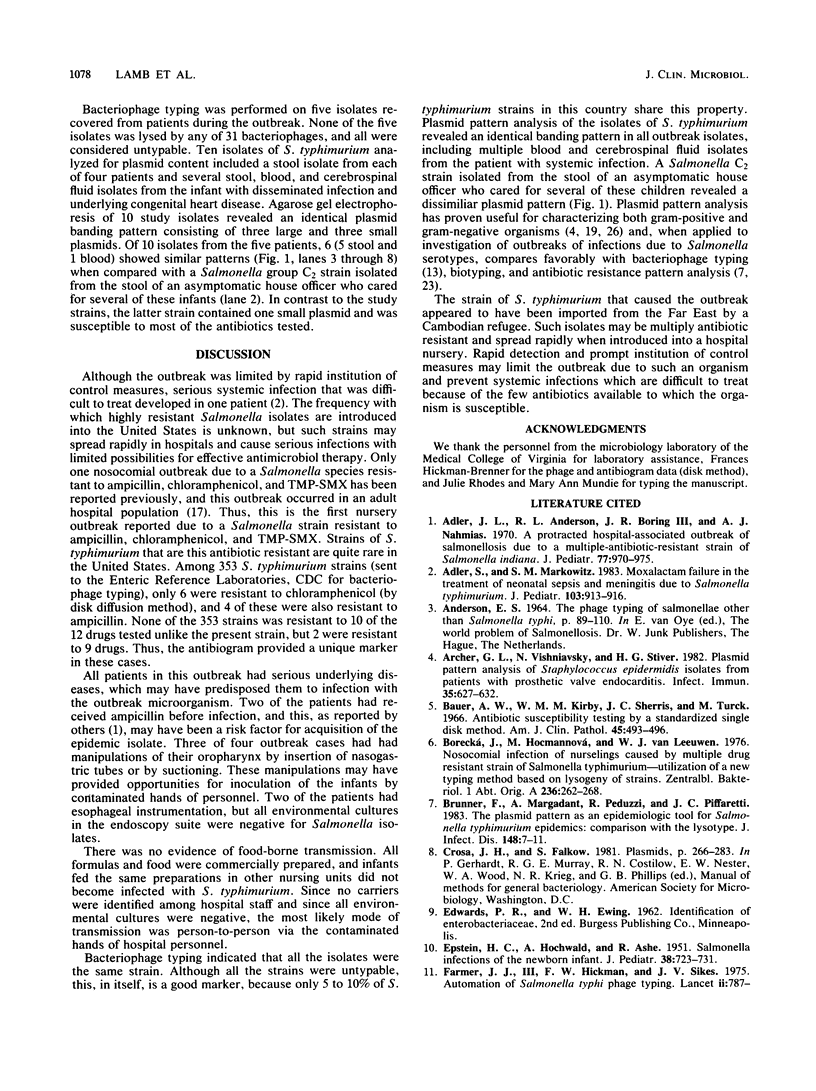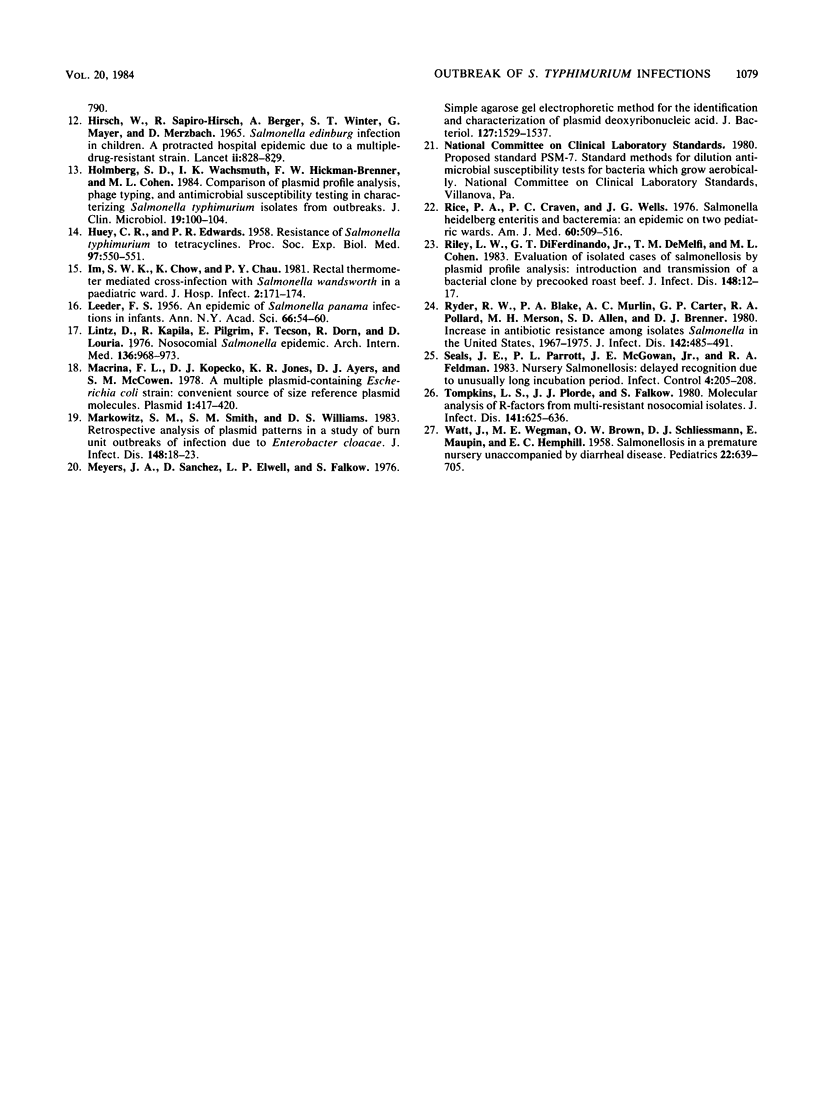Abstract
An outbreak caused by a highly resistant strain of Salmonella typhimurium occurred in a nursery at a university medical center. The outbreak strain, which was resistant to ampicillin, chloramphenicol, and trimethoprim-sulfamethoxazole, was apparently imported from the Far East by a Cambodian refugee. The five patients involved had severe underlying diseases, and bacteremia and meningitis developed in one of these patients. The only reservoir identified was the gastrointestinal tracts of the infected patients, and infection was probably transmitted by the contaminated hands of hospital personnel. The outbreak was rapidly brought under control by isolating cases outside of the nursery and by instituting enteric precautions for infants who remained in the nursery. When compared by disk diffusion susceptibility tests with 353 strains of S. typhimurium tested at the Centers for Disease Control, the imported strain had a unique antibiogram. Bacteriophage typing of the strains revealed that all were untypable; this, in itself, was a good marker, because only 5 to 10% of S. typhimurium isolates in this country have this property. Agarose gel electrophoresis of isolates from the five patients revealed an identical plasmid banding pattern consisting of three large and three small plasmids. Highly resistant strains of S. typhimurium imported from the Far East may spread rapidly when introduced into a hospital nursery. Prompt institution of control measures may limit the outbreak and prevent systemic infections for which there are few effective therapeutic agents.
Full text
PDF



Images in this article
Selected References
These references are in PubMed. This may not be the complete list of references from this article.
- Adler J. L., Anderson R. L., Boring J. R., 3rd, Nahmias A. J. A protracted hospital-associated outbreak of salmonellosis due to a multiple-antibiotic-resistant strain of Salmonella indiana. J Pediatr. 1970 Dec;77(6):970–975. doi: 10.1016/s0022-3476(70)80079-8. [DOI] [PubMed] [Google Scholar]
- Adler S. P., Markowitz S. M. Failure of moxalactam in the treatment of neonatal sepsis and meningitis from Salmonella typhimurium. J Pediatr. 1983 Dec;103(6):913–916. doi: 10.1016/s0022-3476(83)80713-6. [DOI] [PubMed] [Google Scholar]
- Archer G. L., Vishniavsky N., Stiver H. G. Plasmid pattern analysis of Staphylococcal epidermidis isolates from patients with prosthetic valve endocarditis. Infect Immun. 1982 Feb;35(2):627–632. doi: 10.1128/iai.35.2.627-632.1982. [DOI] [PMC free article] [PubMed] [Google Scholar]
- Bauer A. W., Kirby W. M., Sherris J. C., Turck M. Antibiotic susceptibility testing by a standardized single disk method. Am J Clin Pathol. 1966 Apr;45(4):493–496. [PubMed] [Google Scholar]
- Borecká J., Hocmannová M., van Leeuwen W. J. Nosocomial infection of nurselings caused by multiple drug resistant strain of Salmonella typhimurium--utilization of a new typing method based on lysogeny of strains. Zentralbl Bakteriol Orig A. 1976 Nov;236(2-3):262–268. [PubMed] [Google Scholar]
- Brunner F., Margadant A., Peduzzi R., Piffaretti J. C. The plasmid pattern as an epidemiologic tool for Salmonella typhimurium epidemics: comparison with the lysotype. J Infect Dis. 1983 Jul;148(1):7–11. doi: 10.1093/infdis/148.1.7. [DOI] [PubMed] [Google Scholar]
- EPSTEIN H. C., HOCHWALD A., ASHE R. Salmonella infections of the newborn infant. J Pediatr. 1951 Jun;38(6):723–731. doi: 10.1016/s0022-3476(51)80134-3. [DOI] [PubMed] [Google Scholar]
- Farmer J. J., 3rd, Hickman F. W., Sikes J. V. Automation of Salmonella typhi phage typing. Lancet. 1975 Oct 25;2(7939):787–790. doi: 10.1016/s0140-6736(75)80004-3. [DOI] [PubMed] [Google Scholar]
- HUEY C. R., EDWARDS P. R. Resistance of Salmonella typhimurium to tetracyclines. Proc Soc Exp Biol Med. 1958 Mar;97(3):550–551. doi: 10.3181/00379727-97-23801. [DOI] [PubMed] [Google Scholar]
- Hirsch W., Sapiro-Hirsch R., Berger A., Winter S. T., Mayer G., Merzbach D. Salmonella edinburg infection in children. A protracted hospital epidemic due to a multiple-drug-resistant strain. Lancet. 1965 Oct 23;2(7417):828–830. doi: 10.1016/s0140-6736(65)92452-9. [DOI] [PubMed] [Google Scholar]
- Holmberg S. D., Wachsmuth I. K., Hickman-Brenner F. W., Cohen M. L. Comparison of plasmid profile analysis, phage typing, and antimicrobial susceptibility testing in characterizing Salmonella typhimurium isolates from outbreaks. J Clin Microbiol. 1984 Feb;19(2):100–104. doi: 10.1128/jcm.19.2.100-104.1984. [DOI] [PMC free article] [PubMed] [Google Scholar]
- Im S. W., Chow K., Chau P. Y. Rectal thermometer mediated cross-infection with Salmonella wandsworth in a paediatric ward. J Hosp Infect. 1981 Jun;2(2):171–174. doi: 10.1016/0195-6701(81)90026-8. [DOI] [PubMed] [Google Scholar]
- LEEDER F. S. An epidemic of Salmonella panama infections in infants. Ann N Y Acad Sci. 1956 Aug 10;66(1):54–60. doi: 10.1111/j.1749-6632.1956.tb40102.x. [DOI] [PubMed] [Google Scholar]
- Lintz D., Kapila R., Pilgrim E., Tecson F., Dorn R., Louria D. Nosocomial Salmonella epidemic. Arch Intern Med. 1976 Sep;136(9):968–973. [PubMed] [Google Scholar]
- Macrina F. L., Kopecko D. J., Jones K. R., Ayers D. J., McCowen S. M. A multiple plasmid-containing Escherichia coli strain: convenient source of size reference plasmid molecules. Plasmid. 1978 Jun;1(3):417–420. doi: 10.1016/0147-619x(78)90056-2. [DOI] [PubMed] [Google Scholar]
- Markowitz S. M., Smith S. M., Williams D. S. Retrospective analysis of plasmid patterns in a study of burn unit outbreaks of infection due to Enterobacter cloacae. J Infect Dis. 1983 Jul;148(1):18–23. doi: 10.1093/infdis/148.1.18. [DOI] [PubMed] [Google Scholar]
- Meyers J. A., Sanchez D., Elwell L. P., Falkow S. Simple agarose gel electrophoretic method for the identification and characterization of plasmid deoxyribonucleic acid. J Bacteriol. 1976 Sep;127(3):1529–1537. doi: 10.1128/jb.127.3.1529-1537.1976. [DOI] [PMC free article] [PubMed] [Google Scholar]
- Rice P. A., Craven C., Wells J. G. Salmonella heidelberg enteritis and bacteremia. An epidemic on two pediatric wards. Am J Med. 1976 Apr;60(4):509–516. doi: 10.1016/0002-9343(76)90717-8. [DOI] [PubMed] [Google Scholar]
- Riley L. W., DiFerdinando G. T., Jr, DeMelfi T. M., Cohen M. L. Evaluation of isolated cases of salmonellosis by plasmid profile analysis: introduction and transmission of a bacterial clone by precooked roast beef. J Infect Dis. 1983 Jul;148(1):12–17. doi: 10.1093/infdis/148.1.12. [DOI] [PubMed] [Google Scholar]
- Ryder R. W., Blake P. A., Murlin A. C., Carter G. P., Pollard R. A., Merson M. H., Allen S. D., Brenner D. J. Increase in antibiotic resistance among isolates of Salmonella in the United States, 1967-1975. J Infect Dis. 1980 Oct;142(4):485–491. doi: 10.1093/infdis/142.4.485. [DOI] [PubMed] [Google Scholar]
- Seals J. E., Parrott P. L., McGowan J. E., Jr, Feldman R. A. Nursery salmonellosis: delayed recognition due to unusually long incubation period. Infect Control. 1983 Jul-Aug;4(4):205–208. doi: 10.1017/s0195941700058239. [DOI] [PubMed] [Google Scholar]
- Tompkins L. S., Plorde J. J., Falkow S. Molecular analysis of R-factors from multiresistant nosocomial isolates. J Infect Dis. 1980 May;141(5):625–636. doi: 10.1093/infdis/141.5.625. [DOI] [PubMed] [Google Scholar]
- WATT J., WEGMAN M. E., BROWN O. W., SCHLIESSMANN D. J., MAUPIN E., HEMPHILL E. C. Salmonellosis in a premature nursery unaccompanied by diarrheal disease. Pediatrics. 1958 Oct;22(4 Pt 1):689–705. [PubMed] [Google Scholar]



